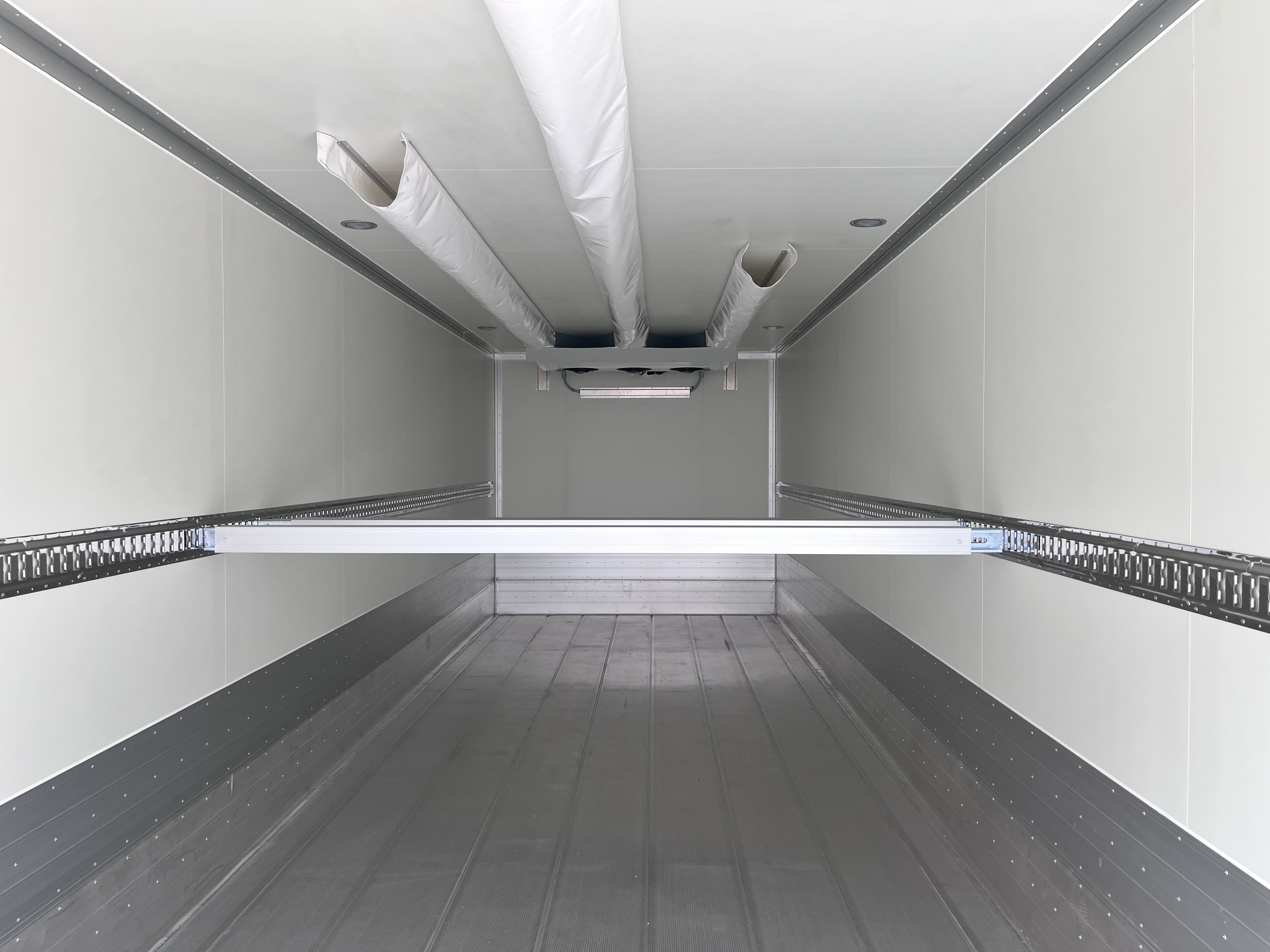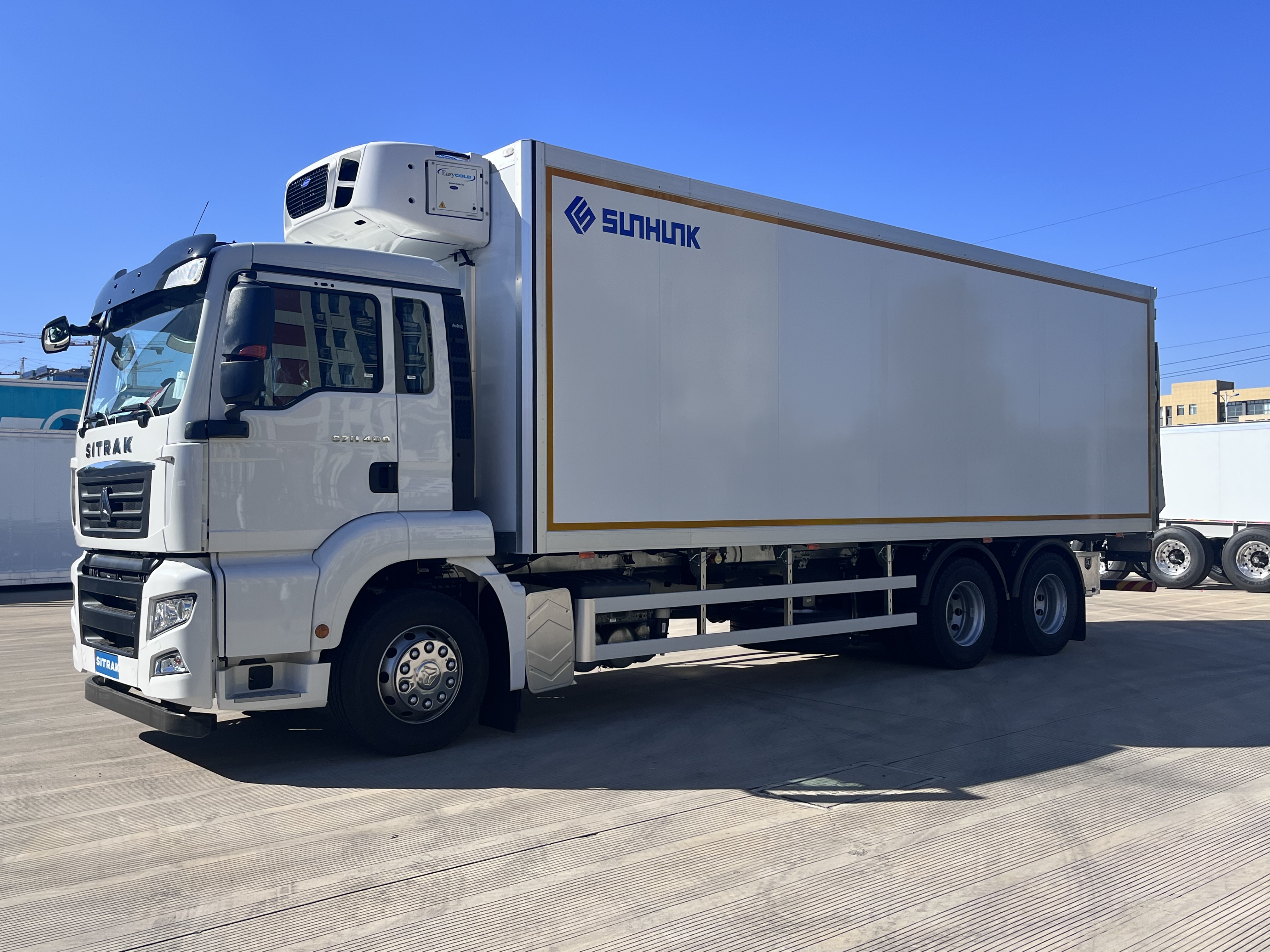- PRODUCTS
- SOLUTION
- SERVICE
- NEWS
- ABOUT US
Refrigerated trucks use a cooling system to maintain low temperatures for goods. The system includes a compressor, condenser, coils (which may be located inside or outside the insulated box), an expansion valve, and a liquid-gas separator. The air conditioning system’s compressor compresses the refrigerant to 200-300 psi, raising the temperature to 120°C, and then sends it to the outside to cool. When it reaches the required 35°C cooling temperature, the refrigerant turns into liquid. The evaporator quickly evaporates the liquid refrigerant, which needs to absorb 2.5 to 3.5 kilowatts of heat from inside the truck’s walls, lowering the temperature to between -18°C and 0°C, depending on the day’s conditions. Additional diesel engines (6 liters) or electricity (consuming about 12 kWh of energy per hour) are used, while side-loading trucks use battery power when charging at the warehouse dock.
The refrigerated truck's cooling system consists of a compressor, condenser, evaporator, and refrigerant. The compressor compresses the refrigerant to 200-300 psi, increasing the temperature to 120°C to 140°C. When passing through the condenser, the refrigerant cools to around 35°C and turns into a liquid. The liquid refrigerant passes through the expansion valve into the evaporator, where it evaporates rapidly, absorbing 2.5 to 3.5 kilowatts of heat from the interior of the compartment, lowering the temperature to between -18°C and 0°C, depending on the specific needs of the frozen or refrigerated cargo.

This highly efficient cooling cycle ensures that refrigerated trucks can maintain stable low temperatures even in harsh transport conditions. Even when outside temperatures reach 40°C, the interior of the compartment can still remain at the set temperature. With 2.5 to 3.5 kilowatts of cooling power per hour, the system can quickly restore temperatures, ensuring the safety of the cargo even with frequent door openings.
The temperature control system in refrigerated trucks is highly accurate, with an error margin of no more than ±0.5°C, ensuring the temperature inside the compartment always stays within the set range. Drivers can adjust the temperature flexibly through a digital control panel based on the different temperature requirements of the goods. Frozen meats usually require an environment below -20°C, while dairy products and fresh fruits and vegetables need to be kept between 0°C and 10°C.
Some advanced refrigerated trucks use multi-compartment temperature control technology, allowing different zones within the compartment to be independently controlled. The front part of the compartment can be kept at -20°C for transporting frozen goods, while the rear part is kept at 5°C for transporting fruits and vegetables that need refrigeration. This technology not only improves the efficiency of transporting goods but also significantly reduces transportation costs.
The insulation design of refrigerated trucks plays a crucial role in the performance of the cooling system. The compartment walls, floors, and doors typically use polyurethane foam with a thermal conductivity of 0.03 W/m·K. The thickness of the insulation material is adjusted based on the type of goods, with the walls generally increasing to 10 cm for frozen goods transportation to ensure that external heat does not penetrate the compartment. Studies show that refrigerated trucks using high-quality insulation materials can reduce heat loss by 30% to 40%.
In terms of airflow management, the compartment's fans can circulate 50 to 60 cubic meters of air per minute to ensure even temperature distribution. If airflow is poor, it may cause a temperature difference of more than 5°C within the compartment, especially in corners or near the doors, which can affect the quality of the goods. By optimizing airflow management, refrigerated trucks can achieve even temperature distribution within the compartment, ensuring that goods are not affected by temperature differences during transportation.
The cooling system in refrigerated trucks is mainly powered by diesel engines or electric systems. Diesel engines typically consume 2 to 3 liters of diesel per hour, providing 8 to 12 kilowatts of cooling power. The advantage of the diesel system is that it can keep the cooling system running continuously, even when the vehicle is parked or the engine is turned off, ensuring the safety of goods during long-distance transportation.

Electric cooling systems have gradually gained popularity in recent years, mainly because their energy efficiency is 20% to 30% higher than that of diesel systems. Electric systems are usually powered by onboard batteries or external power sources and consume 12 to 14 kWh of electricity per hour. Compared to diesel systems, electric cooling systems are more environmentally friendly, reducing emissions and fuel consumption, making them suitable for transportation tasks with stricter carbon emission requirements. In some zero-emission city delivery tasks, electric refrigerated trucks have already become the mainstream choice.